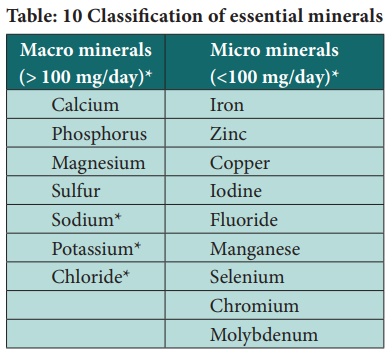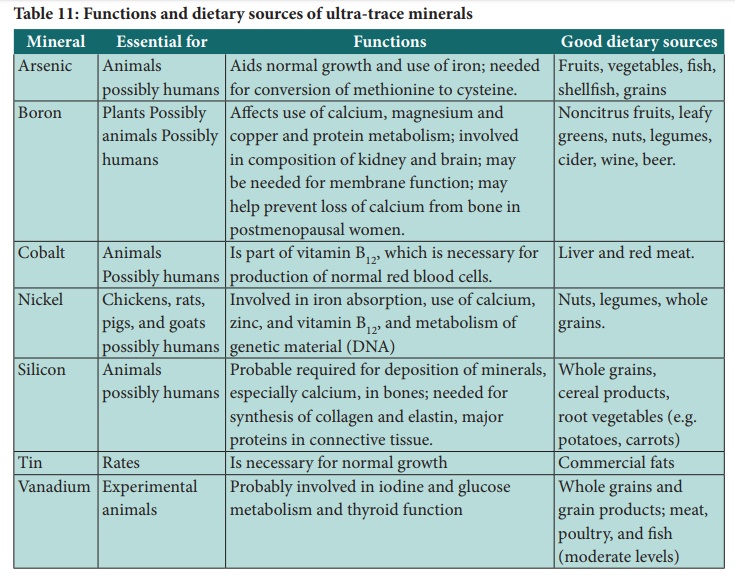Functions, Classification, Absorption, Food sources, Deficiency - Minerals | 12th Nursing : Chapter 5 : Applied Nutrition
Chapter: 12th Nursing : Chapter 5 : Applied Nutrition
Minerals
Minerals
The essential minerals are classified according to their
recommended intake. Macro minerals, also called major minerals, are needed in
amounts greater than 100 milligrams per day. Micro minerals, also called trace
minerals or trace elements, are needed in less than 100 milligrams per day.
Table: 10 Classification of essential minerals

Macro minerals
There are seven macro minerals; calcium, phosphorus, magnesium,
sulfur, sodium, potassium, and chloride. As well as being needed in amounts
greater than 100 milligrams per day, each of the macro minerals makes up more
than 0.01% of the body’s weight.
Calcium
Calcium is by far the most prevalent mineral in the body. About
98% of the 1200 grams (2.5 pounds) of calcium in the average adult body is
found in the bones. Small amounts of calcium (1%) are also found in the
extracellular fluid, certain intracellular structures, and cell membranes.
Function
·
Calcium is one of the
minerals needed for the growth and strength of the bones.
·
Calcium is needed for
muscle contraction
·
Calcium ions are
essential for blood clotting.
·
Calcium is needed for
the functioning of neuro transmitters.
Food sources
Milk and milk products are among the best sources of calcium,
other sources of calcium includes leafy greens, firm tofu, and small fish with
bones, such as sardines.
Deficiency
A severe deficiency of calcium leads to the condition hypocalcemia
resulting in rickets in children and osteomalacia in adults.
Phosphorus
Approximately 85% of the 700 grams of phosphorus in the adult body
is present in the bones. The ratio of calcium to phosphorus in the bones is 2:
1. After calcium, phosphorus is the second most common mineral in the body by
weight.
Function
·
Phosphorus is involved
in a variety of chemical reactions in the body, many of which are related to
energy metabolism.
·
Mineralization of bones
and teeth
·
Facilitation of energy
transaction
·
Absorption and transport
of nutrients
·
Regulation of protein
activity
·
Component of essential
body compounds.
Food sources
In general, good sources of protein are also good sources of
phosphorus. Meat, poultry, fish and eggs are rich in phosphorus. Milk and milk
products, nuts, legumes, cereals and grams are good sources.
Deficiency
A phosphorus deficiency is characterized by weakness, lack of
appetite, fatigue and muscle pain.
Magnesium
About 60% of the body’s magnesium is contained in the bones; most
of the remaining magnesium is present in the muscles and other tissues, with
about 1% circulating extracellular fluids.
Function
·
The activity of hundreds
of enzymes depends on magnesium
·
Magnesium also helps
maintain calcium and potassium homeostasis.
Food sources
Nuts, legumes, dark green leafy vegetables, soya beans and milk
are good sources.
Deficiency
Symptoms of magnesium deficiency include weakness, confusion, lack
of appetite, nausea, and lack of coordination.
Sulfur
Because sulfur is part of the essential amino acid methionine and
the nonessential amino acid cysteine, it is present in the body’s proteins.
Interactions among sulfur atoms in cysteine helps to give proteins their three
dimensional shape.
The Electrolytes
Three of the macrominerals – Sodium, potassium and chloride are
the body’s main electrolytes. The major function of the electrolytes is to
maintain the proper distribution of water inside and outside cells. If this
water balance is not maintained, cells will shrink or swell beyond their normal
size. Sodium and chloride are found in the extracellular fluid; potassium is
found in the intracellular Fluid (ICF).
Sodium
Sodium is the principal cation of extracellular fluid. Human body
has approximately 1.8 g of sodium per kilogram of body weight. The body
regulates the sodium concentration in the extracellular fluid within narrow
limits.
Function
In addition to its role in maintaining the body’s water balance,
sodium functions in maintaining extracellular fluid volume and in regulating
the body’s acid – base balance.
Food sources
The major dietary source of sodium is sodium chloride, more
commonly called table salt. One teaspoon of table salt supplies 2132 milligrams
of sodium.
Deficiency
Excessive sodium loss, not a low dietary intake; is the usual
cause of sodium deficiency. Trauma, long – term diarrhea, vomiting and kidney
disease may also lead to excessive sodium losses.
A sodium deficiency, with fluid levels remaining constant or
increasing, leads to a decrease in the extracellular sodium concentration. As a
result, water migrates into cells, leading to water intoxication. Water
intoxication causes loss of appetite, muscle twitching, mental apathy, coma,
and seizures.
Potassium
The electrolyte potassium is found mainly in the intracellular
fluid
Functions
·
The main function of
potassium, like sodium, is to maintain water balance.
·
Potassium is required
for maintaining a normal heartbeat.
Food sources
This mineral is widely distributed in foods, but fruits and
vegetables are generally the most nutrient – dense sources of potassium.
Deficiency
As with sodium, deficiencies of potassium are usually caused by
excessive losses, not low intakes. Losses occur primarily via the urine; lesser
amounts are lost in sweat. Excessive potassium losses via the kidneys may
result from use of potassium – depleting diuretics, which are often prescribed
to treat high blood pressure. High levels of activity in hot, humid climates
may lead to excessive potassium losses via perspiration. Much potassium can
also be lost through long-term vomiting or prolonged diarrhea.
Symptoms of a potassium deficiency include weakness, loss of
appetite, nausea, listlessness, apprehension, fatigue, irrational behavior,
muscle weakness, and muscle cramping. A severe deficiency may cause an abnormal
heartbeat and possibly death.
Chloride
The electrolyte chloride is found primarily in the extracellular
fluid.
Functions
• Chloride’s major
functions are maintaining the body’s water and electrolyte balance.
·
Chloride is mainly a
component of hydrochloric acid, which is secreted in the stomach and helps in
the digestion of protein.
Food sources
The main dietary sources of chloride is sodium chloride, that is,
table salt. Chloride is also found in many processed food that contain added
salt.
Deficiency
As with the other two electrolytes, chloride deficiency rarely
results from poor dietary intake. Rather, chloride deficiencies are typically
caused by excessive losses due to diarrhea or vomiting, heavy perspiration,
trauma, or kidney disease.
Micro minerals
We require intakes of the essential trace minerals, or micro
minerals, in amounts of less than 100 milligrams per day. The essential trace
minerals are iron, zinc, copper, iodine, manganese, fluoride, chromium,
selenium, and molybdenum.
Iron
About 30% of the iron in the body is stored in the spleen, liver,
and bone marrow. Iron is a constituent of haemoglobin and myoglobin, which are
iron-binding proteins found in red blood cells and muscle, respectively. Iron
also function as a cofactor for a number of enzymes and is required for their
activity.
Deficiency
Iron deficiency develops in stages; the last stage is
iron-deficiency anemia.
Zinc
Most zinc in the body is found in the bones and muscles. This
trace mineral is necessary for optimal activity of many enzymes and for various
bodily processes, including the following:
·
Protein metabolism,
wound healing, and growth
·
Metabolism of DNA, the
genetic material
·
Development of sexual
organs and bones
·
Immune responses
·
Memory formation
Alcohol metabolism
Particularly high needs for zinc occur during growth and
development.
Food sources
Meat, fish, eggs, milk and nuts are rich sources.
Deficiency
A zinc deficiency impairs protein synthesis, collagen formation,
and energy production; it also decreases alcohol tolerance.
Copper
The trace mineral copper is required for proper use of iron by the
body and for the activity of certain enzymes. This trace mineral also aids in
the production of connective tissue, blood vessels, phospholipids, and melanin
(a skin pigment).
Food sources
The main dietary sources of copper are shellfish, whole grains,
legumes, and nuts.
Deficiency
Symptoms include decreased blood levels of copper, fewer white
blood cells, anemia, bone demineralization, deterioration of the nervous
system.
Iodine
The micro mineral iodine is a necessary component of two hormones
produced by the thyroid gland (thyroxine and triiodothyronine). These thyroid
hormones are critical in regulating the body’s metabolic rate.
Food sources
The amount of iodine present in a particular food depends on the
amount of iodine in the environment in which that food was raised. Therefore,
food from the sea lobsters, oysters, sardines etc.
Deficiency
A prolonged deficiency of iodine causes enlargement of the thyroid
gland, known as goiter.
Fluoride
Although some scientists have doubted that fluoride is an
essential nutrient for humans, this trace mineral is currently considered
essential. The main function of fluoride is to harden the bones and teeth.
Food sources
The only good dietary sources of fluoride are fluoridated water,
seafood, seaweed, and tea. Some natural water sources are also high in
fluoride.
Deficiency
Deficiency of fluoride results in the development of dental
caries.
Manganese
The trace mineral manganese is required for normal brain function.
This micro mineral also aids in the synthesis of collagen, urea, fatty acids,
and cholesterol. Manganese is involved in bone growth and is required for the
digestion of protein.
Food sources
Manganese is present in many vegetable foods, and our diets supply
plenty to meet the requirement, which is minimal.
Deficiency
For the above reason, deficiency of this trace mineral has not
been observed in humans, although it can be induced in experimental animals.
Selenium
The best understood role of the micro mineral selenium is its
involvement in an enzyme system that helps to protect cell membranes against
oxidative damage. Thus selenium has an effect similar to that of the antioxidant
vitamin E.
Food sources
Selenium is widely distributed in both animals and plant foods.
Deficiency
Deficiency resulting from low dietary intake is unlikely because
of its wide distribution in animals and plant foods.
Chromium
The trace mineral chromium is involved in the normal use of
glucose and blood lipids and in the functioning of insulin. The active form of
chromium in the body is called the Glucose Tolerance Factor (GTF).
Molybdenum
Molybdenum is required for several enzyme systems in the body. One
of these enzyme systems involved in the formation of uric acid, a waste product
of protein metabolism is excreted in the urine.
Food sources
The molybdenum of plant foods depends on the type of soil in which
they are grown. (Neutral or alkaline soil).
Deficiency
Molybdenum deficiency has not been observed in human beings or any
other species.
3. Ultra trace mineral
Seven minerals present in foods and in human bodies have been
found to be essential nutrients for animals and may be essential for humans,
but nutritional requirements for them have not yet been clearly defined. This
group of minerals sometimes called ultra-trace minerals, includes arsenic,
boron, cobalt, nickel, silicon, tin, and vanadium.
Table 11: Functions and dietary sources of ultra-trace minerals

Related Topics